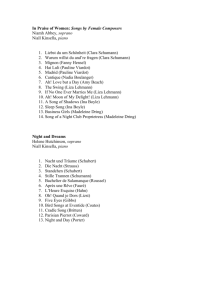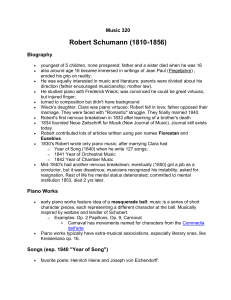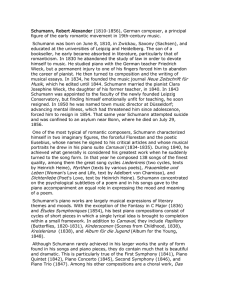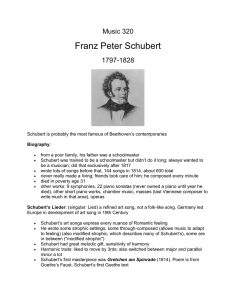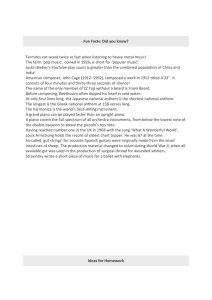Chapter 16: The Early Romantics The Lied
advertisement
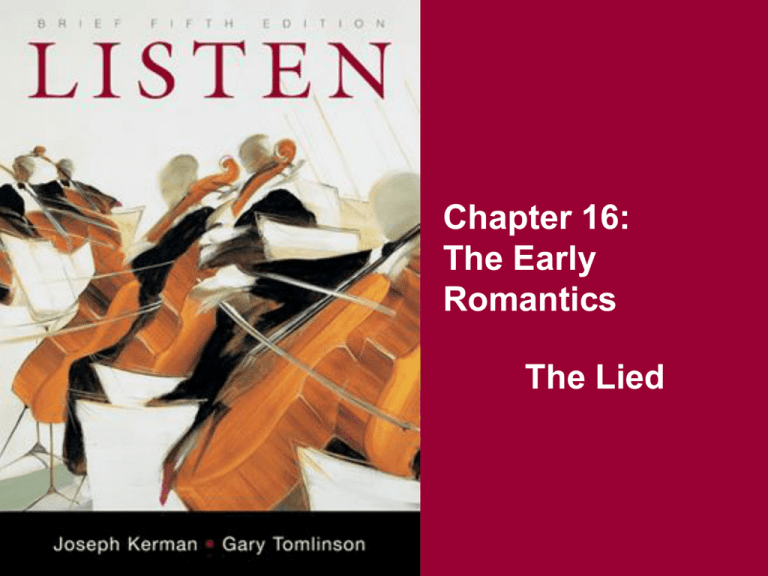
Chapter 16: The Early Romantics The Lied Key Terms Lied Lieder Accompaniment Poetry Mood Through-composed song Strophic song Song cycle The Early Romantics (1) Perhaps the most brilliant generation in the history of music • • • • • • • • Franz Schubert (1797-1828) Hector Berlioz (1803-1869) Felix Mendelssohn (1809-1847) Robert Schumann (1810-1856) Frédéric Chopin (1810-1849) Franz Liszt (1811-1886) Richard Wagner (1813-1883) Giuseppe Verdi (1813-1901) The Early Romantics (2) Profoundly influenced by Beethoven • Influence felt most strongly by Germans Deeply influenced by literary Romanticism • Schubert’s settings of Goethe & Schlegel • Schumann’s enthusiasm for Jean Paul Richter • Universal admiration for Shakespeare The Lied (1) German Lied = song • Special genre of Romantic song with piano Important Romantic “miniature” genre • Evolved in the late 18th century • Flourished in the 19th century Some are simple tunes, others complex They all share certain features— • Accompaniment, poetry, & mood The Lied (2) Piano accompaniment • Contributes significantly to the artistic effect • Piano & voice often equal partners Romantic poetry • Often high-quality poetry • Music echoes poem’s words & meanings Intimate mood • Intended more for living room than concert hall • Performers seem to share emotional insights with you alone Franz Schubert (1797-1828) Earliest (and greatest?) master of the Lied Prolific – wrote nearly 700 songs • And many symphonies, sonatas, quartets, quintets, & sacred works as well Born & trained in Vienna • Vienna Boys Choir Supported by teaching, publications, & contributions from friends • Wrote many works for friends Died in a typhoid epidemic Strophic vs. Through-Composed (1) A song that uses the same music for all stanzas is called strophic • Composer can write only one stanza & use a repeat sign for the rest – AAAA… A song that uses new music for each stanza is through-composed • Composed all the way through – ABCD… Purely strophic & through-composed songs are opposite ends of a spectrum • Mixed settings include – AAAB or ABCA Strophic vs. Through-Composed (2) How do composers decide whether to use strophic or through-composed form? • The poetry often provides clues • If all stanzas are similar in construction & mood, strophic form is often used • Poems with frequent changes of mood or voice are often given through-composed settings Difficult for performers to create • Variety in strophic settings • Unity in through-composed songs Schubert, “Erlkönig” Story song on a ballad poem by Goethe Eight-stanza poem uses many voices • Narrator, father, son, & Erlking Through-composed setting • Many recurring motives, but no two stanzas are the same Deals with death & the supernatural • Erlking is a “murderous demon” or a dark “angel of death” seen only by the dying The Story A furious horseback ride through the night • Father tries to save his deathly ill son The Erlking comes for the child • First he beckons, then cajoles, then threatens and assaults the child The father does not see the demon • He attempts to quiet the boy But by the time they reach home— • The boy is dead in his arms The Music (1) Fast triplets suggest horse’s hooves • The only respite is provided by the Erlking’s supernatural realm Father’s music is low, gruff, stable Son’s music is higher, frantic, unstable • Higher pitch each time he calls “My father!” The Music (2) Erlking’s music is ominously sweet • The furious triplets fade away • His music is light, tuneful, appealing Tension lets up as they reach home Stark recitative announces the boy’s death • Over a simple but very final cadence The Song Cycle A group of songs with a common theme • Sometimes a poetic theme • Sometimes an actual story Sometimes based on a ready-made group • Schubert’s settings of Wilhelm Müller’s Die schöne Müllerin & Winterreise Or the composer can assemble a set • Schubert’s Schwanengesang A unified cycle is more impressive than single “miniatures” Robert Schumann (1810-1856) Studied for career as piano virtuoso • Finger injury pushed him into composition Married Clara, his teacher’s daughter Wrote piano music, songs, and works for orchestra & chamber ensembles Founder of The New Music Journal • Editor & regular music critic • At times signed reviews as “Florestan” or “Eusebius” – two of his alter-egos Attempted suicide – died in an asylum R. Schumann, Dichterliebe Wrote mostly piano works until 1840 Married Clara Wieck in that year • Sudden outpouring of songs & song cycles Dichterliebe (“A Poet’s Love”) Schumann’s most famous song cycle • Based on poems by Heinrich Heine • No story – poems linked by common theme • Traces psychological progression from optimism to disillusionment & despair Heine, “Im wunderschönen Monat Mai” In the wonderfully lovely month of May, When all the buds were bursting, Then it was that in my heart Love broke through. In the wonderfully lovely month of May, When all the birds were singing, Then it was that I confessed to her My longing and desire. R. Schumann, “Im wunderschönen Monat Mai” The first song in Dichterliebe Strophic or through-composed? • How similar or different are the two stanzas? Schumann uses the same piano music before & after each stanza • The piano interlude’s searching, unresolved feeling doesn’t seem to fit the words • An odd way to begin & end a song • Why did Schumann write it this way? Did he misread the poem? R. Schumann, “Die alten, bösen Lieder” The last song in Dichterliebe Strophic or through-composed? • How similar or different are the six stanzas? Does the song evoke the poem’s black humor? How does the mood change in stanza 6? What is Schumann trying to express in the long piano coda at the end? • What kind of ending does this provides for the entire song cycle? Clara Wieck Schumann (1819-1896) Eldest child of Friedrich Wieck • He was a famous piano teacher • He set out to make her a great pianist Clara fell in love with Robert Schumann • Her father opposed their marriage • Clara & Robert took him to court • They won the case & married in 1840 Composed songs, piano & chamber works • But questioned whether a woman should She toured widely after Robert’s death C. Schumann, “Der Mond kommt still gegangen” (1) Strophic or through-composed? • How similar or different are the three stanzas? What is the relationship between piano and voice? • What kind of mood does the piano create? How does Schumann create a sense of climax in the final stanza? What does the piano coda add to the song? C. Schumann, “Der Mond kommt still gegangen” (2) How does Schumann create a sense of climax in the final stanza? • She varies the last half of the melody – it rises higher & then sinks lower than before Conclusions The Lied is an intimate “miniature” work • A significant Romantic form of expression • Two levels of meaning – verbal & musical Its simple forms follow poetic structure • Strophic, through-composed, or a mixture Repetition of stanzas, themes, or motives creates unity Song cycles can explore subjects in depth • Can tell a story or reflect on poetic theme
